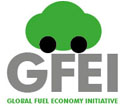
Fuel Taxes
Fuel taxation is an important tool for incorporation of the external costs of transport, including road infrastructure maintenance, adverse health effects due to transport-related pollution, and climate change. It is important that fuel and other taxes work in concert with other GHG reduction measures such as standards in order to ensure consistent GHG reduction outcomes.
Further, fuel taxes can provide incremental incentives to purchase more efficient vehicles. But many countries currently apply low fuel taxation rates or even outright fuel subsidies, which is counterproductive from an energy efficiency standpoint. Fuel taxes can provide revenues to pay for infrastructure costs and can be instrumental to provide funding aimed to the development of sustainable transport, such as mass transit systems and non-motorized facilities.
However, as fuel economy standards become more stringent and governments mandate higher fuel efficiency levels from their national vehicle fleets, fuel tax revenues which help to fund the maintenance of vast transportation infrastructure will decrease. Hybrid vehicles and plug-in hybrids coming onto the market soon are expected to get more than 100mpg, and even lighter vehicles in the near future may reach more than 200 mpg. By 2025 hybrids are expected to make up to 75% of the new car market.
In order to plan for this eventuality, a 2009 Congressional commission recommended that the US transition from a fuel-tax-based revenue system to one ‘measured by miles driven’.
Considering such a transition, there are three potential options:
One is a per-mile tax, which would utilize mobile technology with global positioning systems and a car’s on-board computer to calculate usage and billing. However, there are a number of issues with this option which must be overcome:
- transboundary billing;
- questions of fairness, e.g. heavier vehicles use more gas and are harder on the road;
- privacy issue; and
- the continued use of congestion pricing.
A second option is to use vehicle on-board computers to keep track of a vehicle’s travels, sending the information to a billing center either in real time via roadside beacons or through regular electronic downloads. This would rate the use of different roadways and travelling at peak or off-peak hours of the day, and would also ensure that states received revenue for miles driven within its borders.
A third option is a ‘gas pump model’, whereby the vehicle’s on-board computer unit would collect data, calculate the amount owed and then transmit that information to either a billing agency or to a computer on the gas pump. A third option is a ‘gas pump model’, whereby the vehicle’s on-board computer unit would collect data, calculate the amount owed and then transmit that information to either a billing agency or to a computer on the gas pump.
India Liberalizes Cost of Petrol
In mid-2010 India decided to liberalize the price of petrol, which had previously been pegged at $65-70 per barrel of oil. Although the government has not indicated if fuel taxes will change due to the measure, it is expected that as the international price of oil increases, and thus the price of petrol in India, the transport sector will be incentivized to become more fuel efficient.
With an increase in auto fuel efficiency, less taxes will be gleaned from petrol sales. India will then face a situation other countries now face: a decrease in taxes from petrol sales due to an increase in fuel efficiency in the auto sector, resulting in a deficit in transport infrastructure funds. However, the government of India has indicated that money spent on oil subsidies can now be spent on other social sector programs. For more information on India, see the Indian case study.







